Posted by Elena del Valle on June 26, 2009
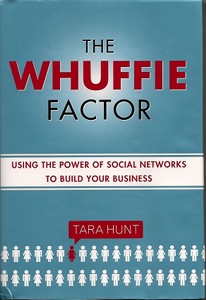
The Whuffie Factor book cover
While millions of people have online profiles and are active in well known social networking sites like Facebook and Twitter, reaping measurable advantages from the profiles does not necessarily follow. Some companies and individuals are convinced these networks are the future and that for those who know what to do and how to do it all the coveted goals will become a reality. As the social networking craze continues a wave of new experts is stepping up to the plate to share their insights with amateurs who want to build a business, develop their presence online or generate business benefits.
In The Whuffie Factor Using the Power of Social Networks to Build Your Business (Crown Business, $25), a 312-page hardcover book published in 2009, Tara Hunt, who has spent the past 15 years participating in or building online communities addresses how-to and best practices issues. She titled the book for the word “whuffie” which refers to the social capital of a person based on his or her actions and contributions to a community and what other people think of him or her.
The book is divided into 10 chapters: How to Be a Social Capitalist, The Power of Community Marketing, Turn the Bullhorn Around and Create Continuous Conversations with Customers, Building Whuffie by Listening to and Integrating Feedback, Become Part of the Community You Serve, Depositing into and Withdrawing from Your Whuffie Account, Be Notable: Eleven Ways to Create Amazing Customer Experiences, Embrace the Chaos, Find Your Higher Purpose, and Whuffie IRL.
Hunt, also known as Miss Rogue, co-founded Citizen Agency, a San Francisco community marketing consulting firm. She now leads the marketing efforts of Intuit’s partner platform.

Click here to buy The Whuffie Factor
Comments:
Filed Under: Books
Posted by Elena del Valle on June 19, 2009
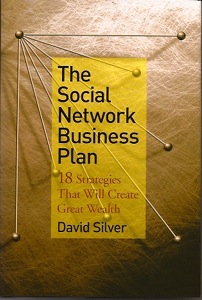
The Social Network Business Plan book cover
In spite of the popularity of social networks in the last years, from a business perspective the question many investors are asking is whether they make business sense. Since social networks are free to users in order to become financially viable they must generate revenue from another source. Many believe the traditional media model that offers advertising space to support editorial content is the key. Others question the effectiveness of ads in the social network pages. In The Social Network Business Plan 18 Strategies That Will Create Great Wealth (Wiley, $24.95), a 191-page hardcover book published this year, David Silver says there is another way.
According to him social networks are the biggest thing since the development of bread 6,000 years ago; and the social networks that prompt consumers to try out, rank and recommend products and services are a revolutionary marketing tool that will create a huge disruption in the way we do business today. He promises readers that through his book they will discover how to create an online recommender community, a new way to launch products and services; how to show their value to vendors; operate several online recommender communities; create a loyal following and make money.
He talks about oligopsony, a shift in power from the producer to the consumer that will benefit consumers by allowing them to receive services that are provided truthfully and efficiently; provide them products that do what they are said to do; and drive prices down noticeably by reducing the need for advertising.
The book is divided into eight chapters: Eighteen Sustainable Revenue Channels, Your Recommender Community as a Theater, Mimic the Bakers and Copy Starbucks, Why Not Start Five Simultaneously? Loyalty and Passion Builders, Disruption: The Sumptuous Impertinence, Should You Sell, or Are You Having Too Much Fun? and Wrap Up.
Silver is the founder of a dozen social networks including onesite.com, iboats.com, and collarfree.com. He provided the seed capital for ActMedia, Cognition Technologies, Frontier Telecommunications, and Intelepeer.

The Social Network Business Plan
Click here to buy The Social Network Business Plan
Comments:
Filed Under: Books
Posted by Elena del Valle on June 5, 2009
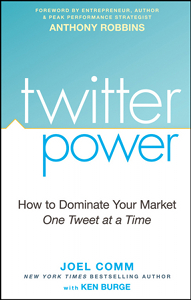
Twitter Power book cover
When a US Airways airplane landed safely in the Hudson River earlier this year many people first heard about it on Twitter, the popular social networking site known for its short postings. In his most recent book Author Joe Comm, a social media enthusiast, points out that the first medium in which news of the recent India terrorist attacks appeared was Twitter. Only several hours later did broadcast media begin coverage. It would appear Twitter is well established as a medium and method to communicate news quickly and efficiently internationally. But does it play a business role?
Comm and Ken Burge, his business partner, argue that it does. In the recently published book, Twitter Power How to Dominate Your Market One Tweet at a Time (Wiley, $24.95) Comm, with Burge’s help and a foreword by Author Anthony Robbins, dedicates 245-pages to the discussion. It took him two months to write the book, according to a representative from his publisher. Comm’s expertise in the area was born from his business experience online. He made a business, started in his bedroom, of providing advice and promoting products online. This in turn led to the seven figure company he now owns, he says in the Introduction of the book.
Unlike Facebook and MySpace Twitter’s usefulness wasn’t obvious to him from the beginning. Over time, the micro blogging website has revealed itself as an “important and easy” way of networking, unearthing new information and finding new customers for him. Twitter also has helped expand the reach of his brand and allowed him to connect with experts and receive advice from people he believes he would have never met otherwise. Most importantly for businesses considering whether to spend their time following and being followed on the 140-character-per-posting site he says Twitter drives traffic to his portal.
Comm argues that to get the most out of Twitter it is best to use it in combination with other social networking sites. In the book, he dedicates time to outlining the basics of social media before discussing Twitter and what makes it special. Next, he explains how to get started on Twitter and, what many readers are likely to be most interested in, how to get a following on the website.
He believes getting followers is easy but keeping them is a challenge. According to him it takes only a few followers to make it to the top 10 percent of people on Twitter. He includes a 30-day step-by-step outline for newbies who want to make inroads on Twitter.
Ultimately, he argues, tweeting is a tool that can lead dedicated users to build beneficial relationships and a loyal following. To accomplish that they have to do more than just post information or comments; they have to connect with customers, problem solve, win referrals, and provide support. If they are successful they will develop a loyal following which may generate visitors, traffic and income. He also mentions Twitter add-on tools and applications and their role and benefits.
Comm describes Twitter as a “virtual giant water cooler” and emphasizes that sales oriented messages are not appropriate. At the same time, he believes many good things can result from the relationships born there for those willing to spend the time and energy to build them.
Comm is also author of The AdSense Code and Click Here to Order. In researching Comm for this article the author also found several websites listing complaints relating to Comm and his online businesses as well as questions regarding his methods. According to a spokesperson for the publishing company, “When you do business with tens of thousands of customers you are bound to have customer service issues. Please note that the BBB page says all issues have been resolved satisfactorily.” Comm did not reply directly. Burge is president of InfoMedia Inc. An eight year veteran of Microsoft, he is responsible for the management of 50 profitable online properties, according to promotional materials.

Joel Comm, author, Twitter Power

Twitter Power book cover
Click here to buy Twitter Power: How to Dominate Your Market One Tweet at a Time
Comments:
Filed Under: Books
Posted by Elena del Valle on May 29, 2009

Celebritize Yourself book cover
Marsha Friedman, a public relations practitioner and self promotion enthusiast, believes that the public gives more credibility to the things celebrities say than to the same comments from a regular person. In her recently published book, Celebritize Yourself The Three Step Method To Increase Your Visibility And Explode Your Business (Warren Publishing, $19.95) she explains why and how readers can develop their reputation for good advantage.
“The term celebrity isn’t just reserved for the stars we read about in the tabloids, but rather, it also refers to experts who are known for being the tops in their chosen fields, many times removed from movie and TV stars,” said Friedman. “Whether you’re a doctor, financial advisor, real estate broker, used car sales person, or even a waiter, you can celebritize yourself in any field.
“Celebrity is a powerful commodity; doors that were once closed can suddenly open. People listen to what they ignored before. New business and money flows to you – not away from you. Most of all, people thank you for sharing your wisdom.”
In the 175-page paperback book Friedman stresses that before becoming famous celebrities were regular people. As examples she cites Julia Child and Erma Bombeck. Child’s background was in publicity and advertising before she followed her passion for French cooking and turned it into a thriving business. Bombeck was a reporter turned homemaker who converted a $3 per column job and into a nationally-syndicated revenue generating idea.
The book is divided into 11 chapters: Everyone Has a Celebrity Within Them! Isn’t It Time You Walked into the Limelight? The Joys of Becoming the Celebrity in Your Field; Why Do You Want to Become a Celebrity? First, Know Thyself; It All Starts with A Book; From Community Celebrity to National Celebrity; How to Be a Great Radio or TV Guest and Quoted in the News! The Celebritize Yourself Quiz; Find Your Media Niche? Now Let’s Get Started! and The Big Payoff.

Marsha Friedman, author, Celebritize Yourself
Friedman, a business woman, publicity expert, radio show host and public speaker, owns Event Management Services, Inc. (EMSI), a national public relations firm she established in 1990. Every week she appears on the nationally syndicated talk radio show “The Family Roundtable” on XM.

Celebritize Yourself book cover
Click here to buy Celebritize Yourself
Comments:
Filed Under: Books
Posted by Elena del Valle on May 8, 2009

The Last Prince of the Mexican Empire book cover
Photos: Teresa Castracane
C.M. Mayo, a resident of Mexico for many years, recently published The Last Prince of the Mexican Empire (Unbridled Books, $26.95) a historical novel set in that country during the reign of Emperor Maximilian von Hapsburg. While the Civil War was tearing the United States apart, Louis Napoleon invaded Mexico and installed Austrian Archduke Maximilian von Hapsburg as emperor. Mayo’s story is set against this post war background. Her debut novel, the result of extensive research, is based in fact.
In the 430-page hardcover book she sets the tale of ambition, heart break, intrigue and politics. A year after becoming emperor the childless monarch took custody of a two-year old half American boy, Prince Agustin Iturbide y Green, making him the Heir Presumptive. The boy was the son of a Mexican diplomat and an American woman; and the grandson of Mexico’s first emperor, who fought for independence from Spain and was executed before a firing squad. Maximilian’s refusal to return the toddler to its saddened parents even while his empire crumbled and the empress toyed with madness catapulted the country into scandal.

Author C.M. Mayo
The author, a part time resident of Washington, D.C., is a translator of contemporary Mexican literature and founding editor of Tameme Chapbooks Cuadernos. Mayo’s other books include Sky Over El Nido, winner of the Flannery O’Connor Award for Short Fiction, Miraculous Air: Journey of a Thousand Miles through Baja California, the Other Mexico, a travel memoir and Mexico: A Traveler’s Literary Companion.

The Last Prince of the Mexican Empire
Click here to buy The Last Prince of the Mexican Empire
Comments:
Filed Under: Books
Posted by Elena del Valle on May 1, 2009
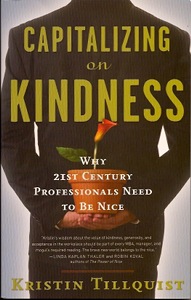
Capitalizing on Kindness
Kirstin Tillquist, a former attorney turned chief of staff to the mayor of the City of Riverside, California, has experience working with politicians and influential people. She firmly believes one of the most, if not the single most, important attitude in business today is kindness. She explains why in her newly published book, Capitalizing on Kindness Why 21st Century Professionals Need to Be Nice (Career Press, $15,99).
The 255-page softcover book is divided into seven chapters: Kindness Capital, The Power of Reputation, The Power of Reciprocity, The Power of Personality, The Power of Thanks, The Power of Connecting, and From Success to Significance. In it she explains that the type of kindness she refers to is a combination of a caring attitude with a smart and strong business approach. Self sacrificing give til you drop and quiet types will not necessarily reap the benefits she speaks of although they may feel rewarded for their actions in private.
She argues that many business people believe falsely that there is a choice between being kind and being successful. Instead, kind people become successful. She sets out to explain to her readers how to be kind in business and develop “kindness capital,” a concept she defines loosely as “what is built up when you consciously set out to be kinder and develop your skills at applying kindness.”
According to Tillquist, kindness results in higher productivity, lower absenteeism, and lower likelihood of being sued. The author emphasizes the benefits of the five Powers of Kindness: Reputation, Reciprocity, Personality, Thanks and Connecting. She is a business consultant, speaker, columnist, and trainer on business kindness.

Capitalizing on Kindness
Click here to buy Capitalizing on Kindness
Posted by Elena del Valle on April 17, 2009

Business War Games book cover
For 25 years Benjamin Gilad, Ph.D. has helped large companies design and run competitive games to make determinations about product and service launches and strategy. This year, the former associate professor published a 223-page hardcover book, Business War Games How Large, Small and New Companies Can Vastly Improve Their Strategies and Outmaneuver the Competition (Career Press, $19.99), designed to make this concept accessible to everyday business people and small companies.
What are war games? An increasingly popular approach to making decisions at the highest echelons of corporate America. These games provide executives a simulation, often relying on sophisticated computer modeling, expert consultants and extensive exercises, to anticipate results, and how customers and the competition will respond to a proposed project launch. The basic concept is to explore ideas that can later, if successful in the games, be implemented in the business and survive in the market.
Gilad believes war games need not be costly or rely on expensive consulting services. In the first chapter of the book, he proposes that the every business person facing a decision involving competitors should have access to the games experience. According to him, they provide a way for decision makers to asses and estimate market changes; test applicable strategies; create and test plans to target the markets of competitors or anticipate threats from competitors; and protect new products and services when they are introduced into the market.
To explain the concept and how to take advantage of it, he divided the book into four sections: From Sand Table to Boardroom, Competitors as Characters, Step-by-Step, and Running a Business War Game. Although he concedes that the term “business war games” may be deceptive since they are not really about wars, he argues that in lieu of a better term or acronym (he mentions IRS for Iterations of Rival Strategies among less desirable options) he prefers war games because it sounds like fun and having fun is one of the most important characteristics of these exercises.
Gilad, who ran war games for Fortune 500 companies for 25 years, has a Ph.D. in economics. A former associate professor of strategy at Rutgers University, he is the founder and president of the Academy of Competitive Intelligence.

Business War Games
Click here to buy Business War Games
Comments:
Filed Under: Books
Posted by Elena del Valle on April 10, 2009

The Facebook Era book cover
Photos: Prentice Hall Professional
For people interested in reaching prospects online social networking, especially websites like Facebook with 150 million members, may offer a desirable target. That forum is so large 400,000 developers have created 24,000 applications for the system. The same characteristic that makes Facebook desirable, its many members, makes tapping it daunting. Social networking advocates believe that because university graduates are accustomed to social networking from their college days and may continue their use as they enter the workforce making social networking sites indispensable as a future business tool. At the same time, eager new users question the tangible long term business benefits of social networking and wonder how they should get started.
This year, a new expert joined the many fans of social networking with a “how to” guide. Clara Shih wrote The Facebook Era: Tapping Online Social Networks to Build Better Products, Reach New Audiences, and Sell More Stuff (Prentice Hall Professional, $24.99) to share suggestions about how business people can leverage social networking to change the way they do business and profit from it.
The 236-page paperback book includes a 60-day action plan to help readers benefit from using social networks. It is divided into 12 chapters in three main parts: A Brief History of Social Media, Transforming the Way We Do Business, and Your Step By Step Guide to Using Facebook for Business. In the first section she examines the current state of social networking; she then explores ways in which specific company areas can benefit from social forums; and in the last four chapters she provides suggestions to implement the ideas she presented in the previous section.

Author Clara Shih
Shih created Faceconnector (formerly Faceforce), one of the first business applications on Facebook. She is also product line director of AppExchange, salesforce.com’s online marketplace for business software-as-a-service applications built by third-party developers. Previously, the author worked in strategy and business operations at Google, and before that as a software developer at Microsoft.
She is the founder and serves on the board of directors of Camp Amelia Technology Literacy Group, an East Palo Alto, California-based 501(c)(3) nonprofit that develops and distributes technology education software and curriculum. Clara holds undergraduate and graduate degrees in economics and computer science from Stanford, and has a Master’s Degree in Internet studies from Oxford, where she was as a United States Marshall Scholar.
Her first book, Using New Media, was commissioned by UNESCO to help teachers, parents, and school administrators in developing countries use digital media to adopt best practices and distribute high-quality content and curriculum. Shih is an immigrant to the United States from Hong Kong and learned English as a second language.
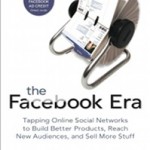
Facebook Era book cover
Click here to buy The Facebook Era
Comments:
Filed Under: Books
Posted by Elena del Valle on March 27, 2009

Bacardi and the Long Fight for Cuba book cover
In Bacardi and the Long Fight for Cuba: The Biography of a Cause (Viking, $27.95) Tom Gjelten, a correspondent for international issues for National Public Radio (NPR), uses a literary magnifying glass to examine the history of five generations of the Bacardi family, world famous rum makers exiled from Cuba. The 413-page hardcover book, published in 2008, is divided into 23 chapters tracing 150 years of the family from the 1860s to the post-Castro era.
The idea for the book was born in 1999 as a way to tell the modern story of Cuba with a new twist, and Gjelten began writing it in 2003. He believes the Bacardis had the type of forward thinking community oriented mentality the island needed and failed to produce.
In the process of researching and writing the book he interviewed 100 people and conducted extensive archival research in Santiago and Havana, Cuba as well as Washington, D.C. and Miami, Florida. He traveled to Cuba 15 times and dedicated many weeks to the project in South Florida.
Gjelten believes the salient aspect of his findings is that although the Bacardi family business remains almost 100 percent family owned the company has survived through five generations of the family, and is thriving as a modern multinational company. The book has two sections of black and white photos of the Bacardi family, factories, buildings and people, including Fidel Castro and Che Guevara.
Gjeltenis, a resident of Arlington, Virginia, is a regular panelist on Washington Week, a PBS radio program. He received George Polk, Robert F. Kennedy and Overseas Press Club awards for his journalistic work from the former Yugoslavia. Prior to Bacardi and the Long Fight for Cuba, he wrote Sarajavo Daily: A City and its Newspaper Under Siege.

Bacardi and the Long Fight for Cuba book cover
Click here to buy Bacardi and the Long Fight for Cuba
Comments:
Filed Under: Books
Posted by Elena del Valle on March 20, 2009
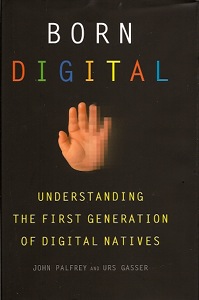
Born Digital Understanding the First Generation of Digital Natives book cover
John Palfrey and Urs Gasser, law professors and researchers, set out to outline the characteristics of the first group of people born and raised in a digital world, those born after 1980. In their recently published book, Born Digital Understanding the First Generation of Digital Natives (Basic Books, $25.95), they explore identity, privacy, safety, addition, violence, creativity, learning, and future prospects issues for this digitally oriented population.
The 375-page hardcover book begins with an introduction followed by 13 chapters: Identities, Dossiers, Privacy, Creators, Pirates, Quality, Overload, Aggressors, Innovators, Learners, Activists and Synthesis. Digital Natives, as the authors call them, live much of their lives connected. Unlike the rest of the population which distinguishes between their online and offline lives, these individuals born in the digital have one single identity with a presence or representation in varied locations.
Digital Natives have common attitudes and behaviors that sometimes contrast with those of Digital Immigrants, those individuals born before the online boom. Digital Natives rely on digital technologies and spend a great deal of time on them; they are likely to multitask; they relate to themselves, their friends and colleagues depending on their interaction with their technology; and they depend on technological tools to use, find and create information and art.
The authors clarify that only one billion of six billion people worldwide have access to digital technologies, and that this gap is widening and creating a divide between the haves and the have nots. At the same time, they point out that even the population that has access to technology may lack the skills necessary to take full advantage of it.
Palfrey, professor of law and vice dean at Harvard University, is also faculty director of the Berkman Center for Internet and Society at Harvard Law School. He chairs the Internet Safety Technical Task Force. Gasser, associate professor of law, St. Gallen, is also faculty director of the Research Center for Information Law and a faculty fellow at the Berkman Center for Internet and Society. He has written or edited six books and more thank 60 articles.
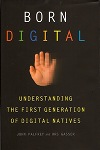
Click here to buy Born Digital: Understanding the First Generation of Digital Natives
Comments:
Filed Under: Books

































